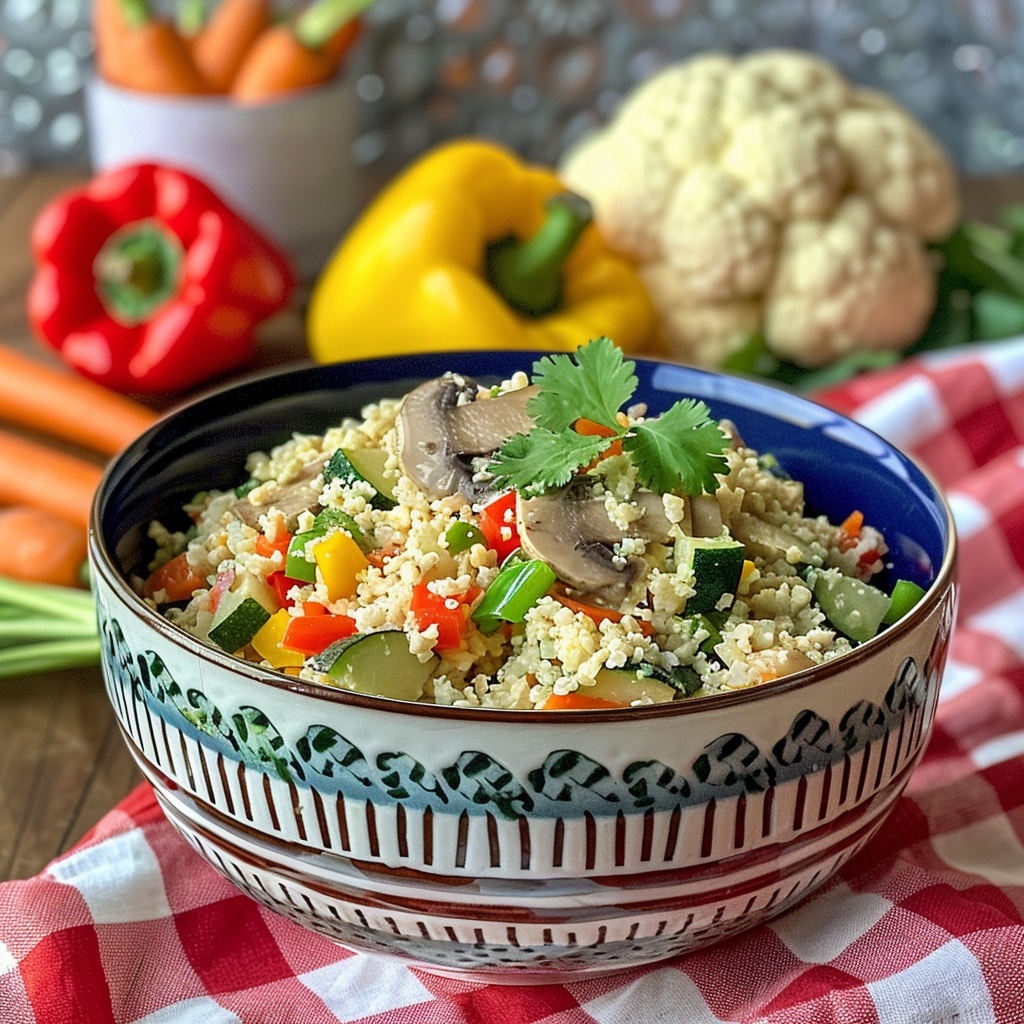Cauliflower Rice Bowls Recipe

Share
Discovering the Versatility of Cauliflower in Cooking
When I first started experimenting with healthier meals, I was amazed by the versatility of cauliflower. It quickly became a favorite in my kitchen, particularly for friends who prefer low-carb meals. I found that cauliflower rice is not only a great grain substitute but also light and customizable. This recipe has became a regular in our home, especially when hosting. It's simple, delicious, and packed with fresh veggies, making it the perfect dish for gatherings or family dinners.
Did You Know?
Cauliflower is an incredibly nutrient-dense vegetable, rich in vitamins C, K, and folate. It's also a great source of fiber and antioxidants. One of its best attributes is how versatile it is—it can be roasted, steamed, grilled, or turned into a low-carb alternative to grains like rice. Cauliflower's mild flavor makes it perfect for absorbing bold seasonings and sauces.
Yield: 4 servings
Ingredients
1 large head of cauliflower, grated or processed into rice-sized pieces
1 tablespoon olive oil
1 cup chopped bell peppers (red, yellow, or green)
1 cup sliced mushrooms
1 cup chopped zucchini
1/2 cup grated carrots
1/2 cup chopped green onions
2 cloves garlic, minced
1 tablespoon soy sauce (or tamari for gluten-free)
1 teaspoon sesame oil
1 tablespoon fresh lime juice
1/4 cup chopped fresh cilantro
Salt and pepper to taste
Instructions
Prepare the Cauliflower Rice:
Heat the olive oil in a large skillet over medium heat. Add the grated cauliflower and cook for 5-7 minutes, stirring occasionally, until tender.
Personal Tip: Using freshly grated cauliflower ensures the best texture, as pre-packaged versions can sometimes be too moist or soggy.
Cook the Vegetables:
In the same skillet, add the bell peppers, mushrooms, zucchini, carrots, and green onions. Cook for another 5-7 minutes until the vegetables are tender.
Personal Tip: Don’t overcook the vegetables; keeping them slightly crisp adds a nice texture to the dish.
Add Aromatics:
Stir in the minced garlic and cook for 1 minute until fragrant.
Personal Tip: Adding garlic last prevents it from burning and ensures a fresh, robust flavor.
Season and Combine:
Add the soy sauce, sesame oil, lime juice, salt, and pepper. Toss to combine everything well.
Personal Tip: A splash of lime juice at the end brightens up the flavors, making the dish even more refreshing.
Serve:
Divide the cauliflower rice mixture into four bowls. Garnish with chopped cilantro and serve immediately.
Personal Tip: For a heartier meal, add a protein like tofu or tempeh on top before serving.
Nutritional Information (Per Serving):
Calories: 180, Protein: 5g, Carbohydrates: 20g, Sugars: 7g, Total Fat: 10g, Saturated Fat: 1.5g, Sodium: 500mg, Fiber: 6g
Kitchen Tips, Great Ideas, How to Save Money
- Cauliflower: Purchase cauliflower when it's in season or on sale. Frozen cauliflower rice is also a convenient and often cost-effective option.
- Vegetable Choices: Use any vegetables you have on hand. Broccoli, snap peas, and spinach are excellent additions or substitutes.
- Seasoning Variations: Experiment with different seasonings like curry powder, cumin, or smoked paprika to change the flavor profile.
- Protein Boost: Add plant-based proteins like tofu, tempeh, or chickpeas to make the meal more filling.
- Leftovers: Store leftovers in an airtight container in the refrigerator for up to 3 days. Reheat in a skillet or microwave before serving.
- Meal Prep: Prepare the cauliflower rice and chop the vegetables ahead of time to make this dish even quicker to put together on busy nights.
- Oil Alternatives: Use coconut oil or avocado oil for a different flavor and health benefits.
- Low-Sodium: Use low-sodium soy sauce or tamari to reduce the sodium content of the dish.
- Garnishing: Add toppings like avocado slices, toasted sesame seeds, or a drizzle of sriracha for extra flavor and texture.
- Eco-Friendly: Use reusable produce bags when shopping for vegetables and a silicone baking mat for roasting.
Let's Learn About Cauliflower
Cauliflower is part of the cruciferous vegetable family, which includes broccoli and cabbage. It's primarily grown in cool climates and harvested by hand to prevent damage to its fragile heads. There are several varieties of cauliflower, including the common white variety, as well as purple, green, and orange varieties. Each type has a slightly different flavor profile, but all are packed with nutrients like vitamin C, K, and folate. It's important to buy organic cauliflower when possible, as conventional varieties can be treated with pesticides. When selecting cauliflower, look for firm heads with tightly packed florets and avoid any with brown spots or wilting leaves. Store in the refrigerator to keep it fresh for several days.


